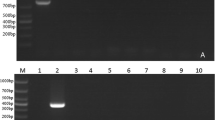Abstract
Theileria sp. MK in sheep and goats were detected first time by polymerase chain reaction (PCR) and detection limit of PCR and reverse line blotting (RLB) were compared. A part of 18S ssu rRNA gene was amplified from blood samples that were taken from sheep and goats naturally infected with Theileria sp. MK by PCR. Detection limit of both PCR and RLB methods was one infected cell in 107 sheep erythrocytes. Nine hundred twenty field samples that had been tested previously by RLB were evaluated by the PCR assay. As found by RLB previously, 12 of 920 (1.30%) samples were detected as positive by PCR. Two positive PCR products, one of which was from sheep and the other from goat, were sequenced. These sequences were identical to the reported nucleotide sequence of Theileria sp. MK. It is concluded that the PCR described in this study will be useful for epidemiological studies and for discrimination between Theileria sp. MK and other Theileria species. In addition, PCR has superiority over RLB because of its ease of use and time period required.


Similar content being viewed by others
References
Ahmed JS, Luo J, Schnittger L, Seitzer U, Jongejan F, Yin H (2006) Phylogenetic position of small ruminant infecting piroplasms. Ann NY Acad Sci 1081:498–504
Aktas M, Dumanli N, Cetinkaya B, Cakmak A (2002) Field evaluation of PCR in detecting Theileria annulata infection in cattle in the east of Turkey. Vet Rec 150:548–549
Aktas M, Altay K, Dumanli N (2005) Development of a polymerase chain reaction method for diagnosis of Babesia ovis infection in sheep and goats. Vet Parasitol 133:277–281
Alani AJ, Herbert IV (1988) Pathogenesis of infection with Theileria recondita (Wales) isolated from Haemaphysalis punctata from North Wales. Vet Parasitol 4:293–301
Allsopp BA, Baylis HA, Allsopp MT, Cavalier-Smith T, Bishop RP, Carrington DM, Sohanpal B, Spooner P (1993) Discrimination between six species of Theileria using oligonucleotide probes which detect small subunit ribosomal RNA sequences. Parasitology 107:157–165
Almeria S, Castella J, Ferrer D, Ortuno A, Estrade-Pena A, Gutierrez J (2001) Bovine piroplasma in Minorca (Baleric Islands, Spain): a comparison of PCR-based and light microscopy detection. Vet Parasitol 99:249–259
Altay K, Dumanli N, Holman PJ, Aktas M (2005) Detection of Theileria ovis infected sheep by nested PCR. Vet Parasitol 127:99–104
Altay K, Dumanli N, Aktas M (2007) Molecular identification, genetic diversity and distribution of Theileria and Babesia species infecting small ruminants. Vet Parasitol 147:161–165
Clamp M, Cuff J, Searle SM, Barton GJ (2004) The Jalview Java Alignment Editor. Bioinformatics 20:426–427
d’Oliveira C, Van der Weide M, Habela MA, Jacquiet P, Jongejan F (1995) Detection of Theileria annulata in blood samples of carrier cattle by PCR. J Clin Microbiol 33:2665–2669
Dumanli N, Aktas M, Cetinkaya B, Cakmak A, Koroglu E, Saki CE, Erdogmus Z, Nalbantoglu S, Ongor H, Simsek S, Karahan M, Altay K (2005) Prevalence and distribution of tropical theileriosis in eastern Turkey. Vet Parasitol 127:9–15
Friedhoff KT (1997) Tick-borne diseases of sheep and goats caused by Babesia, Theileria or Anaplasma spp. Parasitologia 39:99–109
Gubbels JM, de Vos AP, van der Weide M, Viseras J, Schouls LM, de Vries E, Jongejan F (1999) Simultaneous detection of bovine Theileria and Babesia species by reverse line blot hybridization. J Clin Microbiol 37:1782–1789
Hashemi-Fesharki R (1997) Tick-borne diseases of sheep and goats and their related vectors in Iran. Parasitologia 39:115–117
Kirvar E, Ilhan T, Katzer F, Wilkie G, Hooshmand-Rad P, Brown CGD (1998) Detection of Theileria lestoquardi (hirci) in ticks, sheep, goats using polymerase chain reaction. Ann NY Acad Sci 849:52–62
Kirvar E, Ilhan T, Katzer F, Wilkie G, Hooshmand-Rad P, Zweygarth E, Gestenberg C, Phipps P, Brown CGD (2000) Detection of Theileria annulata in cattle and vector ticks by PCR using the Tams1 gene sequences. Parasitology 120:245–254
Nagore D, García-Sanmartín J, García-Pérez AL, Juste RA, Hurtado A (2004) Identification, genetic diversity and prevalence of Theileria and Babesia species in a sheep population from Northern Spain. Int J Parasitol 34:1059–1067
Oura CAL, Bishop RP, Wampande EM, Lubega GW, Tait A (2004) Application of a reverse line blot assay to the study of haemoparasites in cattle in Uganda. Int J Parasitol 34:603–613
Passos LMF, Bell-Sakyi L, Brown CGD (1998) Immunochemical characterization of in vitro culture-derived antigens of Babesia bovis and Babesia bigemina. Vet Parasitol 76:239–249
Schnittger L, Yin H, Jianxun L, Lugwing W, Shayan P, Rahbari S, Voss-Holtmann A, Ahmed JS (2000) Ribosomal small-subunit RNA gene-sequence analysis of Theileria lestoquardi and a Theileria species highly pathogenic for small ruminants in China. Parasitol Res 86:352–358
Schnittger L, Yin H, Qi B, Gubbels MJ, Beyer D, Nieman S, Jongejan F, Ahmed JS (2004) Simultaneous detection and differentiation of Theileria and Babesia parasites infecting small ruminants by reverse line blotting. Parasitol Res 92:189–196
Thompson JD, Higgins DG, Gibson TJ (1994) CLUSTAL W: improving the sensitivity of progressive multiple sequence alignment through sequence weighting, position specific gap penalties and weight matrix choice. Nucleic Acids Res 22:4673–4680
Uilenberg G (2001) Babesiosis. In: Servise MW (ed) Encyclopedia of Arthropod-transmitted infection of man and domestic animals. CABI Publishing, Wallinford, pp 53–60
Acknowledgments
This study was supported by a grant (104 O 393) from the Scientific and Technical Research Council of Turkey (TUBITAK).
The authors would like to thank all veterinarians and technicians for their kind help during sample collection for this study. The gifts of genomic DNA from Dr. Jabbar Ahmed, Dr. Dirk Geysen, Dr. Bernard Carcy and Dr. Ana Hurtado are gratefully acknowledged.
Author information
Authors and Affiliations
Corresponding author
Additional information
Nucleotide sequence data reported in this paper are available in GenBank, EMBL and DDBJ databases under accession numbers EU262482 and EU262483.
Rights and permissions
About this article
Cite this article
Altay, K., Aktas, M., Dumanli, N. et al. Evaluation of a PCR and comparison with RLB for detection and differentiation of Theileria sp. MK and other Theileria and Babesia species of small ruminants. Parasitol Res 103, 319–323 (2008). https://doi.org/10.1007/s00436-008-0973-9
Received:
Accepted:
Published:
Issue Date:
DOI: https://doi.org/10.1007/s00436-008-0973-9




